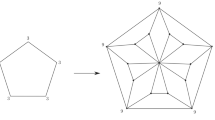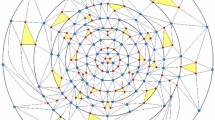Abstract
Let φP (C 7) ( φT (C 7)) be the minimum integer k with the property that each 3-polytope (respectively, each plane triangulation) with minimum degree 5 has a 7-cycle with all vertices of degree at most k. In 1999, Jendrol’, Madaras, Soták, and Tuza proved that 15 ≤ φT (C 7) ≤ 17. It is also known due to Madaras, φSkrekovski, and Voss (2007) that φP (C 7) ≤ 359.
We prove that φP (C 7) = φT (C 7) = 15, which answers a question of Jendrol’ et al. (1999).
Similar content being viewed by others
References
Steinitz E., “Polyheder und Raumeinteilungen,” Enzykl. Math. Wiss. (Geometrie), 3, No. 3AB12, 1–139 (1922).
Wernicke P., “über den Kartographischen Vierfarbensatz,” Math. Ann., 58, 413–426 (1904).
Franklin P., “The four color problem,” Amer. J. Math., 44, 225–236 (1922).
Lebesgue H., “Quelques conséquences simples de la formule d’Euler,” J. Math. Pures Appl., 19, 27–43 (1940).
Jendrol’ S. and Madaras T., “On light subgraphs in plane graphs with minimum degree five,” Discuss. Math. Graph Theory, 16, 207–217 (1996).
Borodin O. V. and Woodall D. R., “Short cycles of low weight in normal plane maps with minimum degree 5,” Discuss. Math. Graph Theory, 18, No. 2, 159–164 (1998).
Kotzig A., “From the theory of Eulerian polyhedra,” Mat. Čas., 13, 20–34 (1963).
Borodin O. V., “Solving the Kotzig and Grünbaum problems on the separability of a cycle in planar graphs,” Mat. Zametki, 46, No. 5, 9–12 (1989). (English translation: Math. Notes, 46, No. 5–6, 835–837 (1989).)
Grünbaum B., “Polytopal graphs,” in: Studies in Graph Theory. Part II (ed. D. R. Fulkerson), Washington, D. C., Math. Assoc. Amer., Vol. 12, 1975, pp. 201–224 (MAA Stud. Math.).
Plummer M. D., “On the cyclic connectivity of planar graphs,” in: Graph Theory and Applications, Springer-Verlag, Berlin, 1972, pp. 235–242.
Borodin O. V., Ivanova A. O., and Woodall D. R., “Light C4 and C5 in 3-polytopes with minimum degree 5,” Discrete Math., 334, 63–69 (2014).
Jendrol’ S. and Voss H.-J., Light Subgraphs of Graphs Embedded in the Plane and in the Projective Plane: a Survey, [Preprint / Inst. Algebra MATH–AL–2–2001], Discrete Math. TU Dresden (2001).
Jendrol’ S. and Voss H.-J., “Light subgraphs of graphs embedded in the plane and in the projective plane: a survey,” Discrete Math., 313, No. 4, 406–421 (2013).
Jendrol’ S., Madaras T., Soták R., and Tuza Z., “On light cycles in plane triangulations,” Discrete Math., 197/198, 453–467 (1999).
Madaras T. and Soták R., “The 10-cycle C10 is light in the family of all plane triangulations with minimum degree five,” Tatra Mt. Math. Publ., 18, 35–56 (1999).
Mohar B., Škrekovski R., and Voss H.-J., “Light subgraphs in planar graphs of minimum degree 4 and edge-degree 9,” J. Graph Theory, 44, 261–295 (2003).
Borodin O. V., Ivanova A. O., and Kostochka A. V., “Every 3-polytope with minimum degree 5 has a 6-cycle with maximum degree at most 11,” Discrete Math., 315/316, 128–134 (2014).
Madaras T., Škrekovski R., and Voss H.-J., “The 7-cycle C7 is light in the family of planar graphs with minimum degree 5,” Discrete Math., 307, 1430–1435 (2007).
Borodin O. V., “Structural properties of plane maps with minimum degree 5,” Math. Nachr., 18, 109–117 (1992).
Ferencová B. and Madaras T., “Light graph in families of polyhedral graphs with prescribed minimum degree, face size, edge and dual edge weight,” Discrete Math., 310, 1661–1675 (2010).
Borodin O. V., “Structural theorem on plane graphs with application to the entire coloring,” J. Graph Theory, 23, No. 3, 233–239 (1996).
Borodin O. V., “Colorings of plane graphs: a survey,” Discrete Math., 313, No. 4, 517–539 (2013).
Borodin O. V., “On acyclic colorings of planar graphs,” Discrete Math., 25, 198–223 (1979).
Author information
Authors and Affiliations
Corresponding author
Additional information
Original Russian Text Copyright © 2015 Borodin O.V. and Ivanova A.O.
The authors were supported by the Russian Foundation for Basic Research (Grants 12–01–00631 and 15–01–05867 for the first author and Grant 12-01-98510 for the second author) and the State Maintenance Program for the Leading Scientific Schools of the Russian Federation (Grant NSh-1939.2014.1). The second author worked within the governmental task “Organization of Scientific Research.”
Novosibirsk; Yakutsk. Translated from Sibirskiĭ Matematicheskiĭ Zhurnal, Vol. 56, No. 4, pp. 775–789, July–August, 2015; DOI: 10.17377/smzh.2015.56.405.
Rights and permissions
About this article
Cite this article
Borodin, O.V., Ivanova, A.O. Each 3-polytope with minimum degree 5 has a 7-cycle with maximum degree at most 15. Sib Math J 56, 612–623 (2015). https://doi.org/10.1134/S0037446615040059
Received:
Published:
Issue Date:
DOI: https://doi.org/10.1134/S0037446615040059




